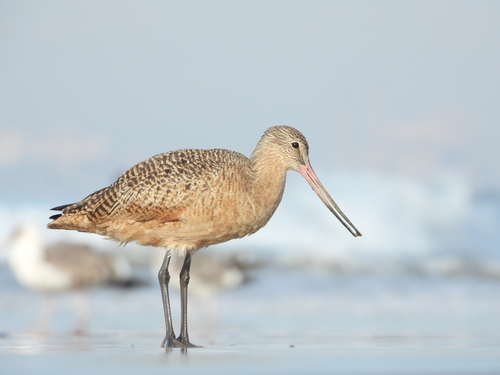
Marbled Godwit
The Marbled Godwit (*Limosa fedoa*) is a large shorebird known for its long, upturned bill and distinctive marbled plumage. It plays a vital role in coastal and wetland ecosystems, primarily as a predator of invertebrates. This species undertakes impressive long-distance migrations between breeding grounds in North America and wintering areas along the coasts. While not currently considered globally threatened, some populations face localized threats. The Marbled Godwit holds no widely known strong cultural significance, but its presence is appreciated by birdwatchers and contributes to the biodiversity of its habitats.
40-50 cm
Length
70-80 cm
Wingspan
Least Concern
Conservation Status
Distribution
Breeds primarily in the prairies of North America, including parts of Canada (Alberta, Saskatchewan, Manitoba) and the United States (Montana, North Dakota, South Dakota). Migrates to coastal areas, wintering along the Pacific, Atlantic, and Gulf coasts of the United States, Mexico, and Central America. Some populations may reach South America.
Lifespan
Up to 15 years in the wild, based on banding records.
Marbled Godwit's Habitat
Habitat Types
Coastal mudflats, Salt marshes, Estuaries, Inland wetlands (during breeding season), Grasslands (during breeding season)
Climate Zones
Temperate, Subtropical, Tropical (during wintering)
Adaptations
Their long, sensitive bill is adapted for probing deep into mud and sand to find prey. Their long legs allow them to wade in shallow water. They have a high tolerance for salinity in coastal environments.
Variations
Two subspecies are generally recognized: *L. f. fedoa* (breeding in the northern Great Plains) and *L. f. beringiae* (breeding in Alaska). The Alaskan subspecies tends to be larger and darker.
Appearance
Breeding Plumage
Breeding plumage is characterized by a richly mottled brown, buff, and black back, with cinnamon underparts. Non-breeding plumage is paler and grayer overall.
Seasonal Feather Changes
Significant changes occur between breeding and non-breeding plumage. Molting occurs twice a year.
Sex Based Plumage Differences
Males and females have similar plumage, although females may have slightly less intense coloration during breeding season.
Notable Features
Long, upturned bill (pink at the base, darkening towards the tip), Marbled brown and buff upperparts, Cinnamon underwing linings (visible in flight), Long, dark legs
Diet and Feeding
Primary Foods
Marine invertebrates (crabs, mollusks, worms), Insects (during breeding season), Small crustaceans, Occasionally small fish
Foraging Behavior
Probes deeply into mud and sand with its long bill, using tactile sensitivity to locate prey. Often feeds in flocks, especially during migration and wintering.
Specializations
The upturned bill is a key specialization for probing in soft substrates. The bill's sensitive tip allows it to detect prey by touch.
Seasonal Diet Variations
Diet shifts from primarily insects during the breeding season to marine invertebrates during migration and wintering.
Behavior
Social Structure
Forms flocks during migration and wintering, sometimes numbering in the hundreds or thousands. More territorial during the breeding season.
Communication
Loud, ringing calls, especially during flight, A variety of vocalizations used during courtship and territorial defense, Visual displays, such as wing-lifting and tail-fanning
Migration
Long-distance migrant. Travels between breeding grounds in interior North America and coastal wintering areas. Migratory routes often follow coastlines or major river systems.
Territorial or Group Behaviors
Territorial during the breeding season, defending nesting and feeding areas. Forms large flocks during migration and wintering, often foraging and roosting together.
Conservation
Threats
Habitat loss and degradation (coastal development, wetland drainage), Climate change (sea level rise, altered precipitation patterns), Pollution (contaminants in coastal ecosystems), Disturbance from human activities
Protection Programs
Western Hemisphere Shorebird Reserve Network (WHSRN), Migratory Bird Treaty Act (in the United States), Species at Risk Act (in Canada)
Local National Laws
Protected under various state and provincial laws in the United States and Canada.
Population Trend
Stable or slightly decreasing
Population Estimates
Estimated global population of around 170,000 individuals.
Interesting Facts
They can swim.
Although primarily a wading bird, Marbled Godwits can swim if necessary, especially as chicks.
Their bill is sensitive to touch.
The tip of the bill contains specialized sensory receptors that help them detect prey buried in the mud.
They are among the longest-billed shorebirds in North America.
Their distinctive bill is a key adaptation for their foraging strategy.
Faqs about Marbled Godwit
What is the difference between a Marbled Godwit and a Willet?
Marbled Godwits have a long, upturned, pinkish bill, while Willets have a shorter, straighter, and darker bill. Willets also have a distinctive black and white wing pattern in flight.
Where can I see Marbled Godwits?
Look for them along coastlines, mudflats, and estuaries during migration and winter. During the breeding season, they can be found in prairie wetlands of the northern Great Plains.
Are Marbled Godwits endangered?
No, they are currently classified as Least Concern by the IUCN. However, some populations are facing threats and are considered of conservation concern in certain regions.
Copyright @ Nature Style Limited. All Rights Reserved.
 English
English